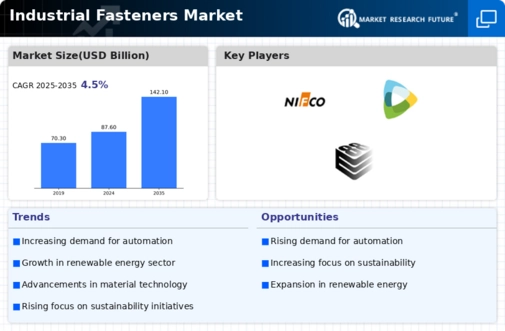Market Share
Industrial Fasteners Market Share Analysis
THREADED AUTOMOTIVE FASTENERS: DOMINATING THE MARKET LANDSCAPE
In the intricate tapestry of the automotive fasteners market, the threaded segment takes center stage, commanding a substantial market share of 79.4% in 2019 with a market value of USD 22,826.6 million. This dominance is anticipated to persist, with the threaded segment projected to register a commendable Compound Annual Growth Rate (CAGR) of 5.75% during the forecast period. The robust growth in this segment underscores the pivotal role played by threaded automotive fasteners, commonly known as bolts, in the manufacturing and assembly processes within the automotive industry.
Threaded automotive fasteners, characterized by a head at one end and secured with a nut at the other end, exemplify the fundamental design that has been a cornerstone in mechanical connections for centuries. The functionality of these fasteners revolves around their ability to be inserted through a hole and subsequently fastened with a nut. The intricate interplay of threads on both the bolt and nut ensures a secure connection through a circular motion, offering a reliable and robust fastening solution.
The versatility of threaded automotive fasteners is evident in the diverse range of types that cater to specific applications within the automotive landscape. U-bolts, for instance, find their utility in securing pipes or tubes to cylindrical objects, while hub bolts play a critical role in securing automotive hubs. Wheel bolts, a familiar sight in the automotive world, are essential for attaching wheels to the hub. The spectrum extends further to include screws, washers, and studs, each serving distinct purposes in the complex assembly of automotive components.
In the realm of nuts, threaded automotive fasteners exhibit a rich diversity, with each type designed to meet specific requirements in the assembly process. T-nuts, collar nuts, locking nuts, lug nuts, jam nuts, and hex nuts represent a myriad of options that cater to different needs within the automotive manufacturing landscape. The intricate design and functionality of these nuts contribute to the overall stability, durability, and safety of assembled automotive components.
The enduring popularity of threaded automotive fasteners can be attributed to their reliability, strength, and adaptability to a multitude of applications. Their ability to withstand varying levels of stress, pressure, and environmental conditions makes them indispensable in the automotive manufacturing ecosystem. As the automotive industry continues to evolve, threaded fasteners remain a cornerstone in ensuring the structural integrity and performance of vehicles.
Within the threaded segment, the future trajectory is marked by a projected CAGR of 5.75% during the forecast period. This growth is indicative of the sustained demand for threaded automotive fasteners as automotive manufacturers continue to innovate and optimize their production processes. The threaded segment not only represents a fundamental aspect of automotive manufacturing but also mirrors the enduring legacy of threaded fasteners as a reliable and time-tested solution in the ever-evolving automotive landscape.
In contrast, the non-threaded segment, valued at USD 5,913.4 million, exhibits a higher projected CAGR of 6.70%. While the non-threaded segment holds a smaller market share, its faster growth rate underscores the evolving dynamics and emerging applications within the automotive fasteners market. Non-threaded fasteners, characterized by their unique designs and applications, contribute to the overall diversity and adaptability of fastening solutions in the automotive industry.
In conclusion, the threaded automotive fasteners segment stands tall as a cornerstone in automotive manufacturing, representing reliability, strength, and adaptability. As the automotive industry continues its march towards innovation and efficiency, threaded fasteners remain a constant, ensuring the robustness and integrity of vehicles on the road. The intricate dance of bolts, nuts, and other threaded fasteners plays a vital role in shaping the future of automotive manufacturing, where tradition meets innovation in a seamless blend of time-tested reliability and cutting-edge technology.







Leave a Comment